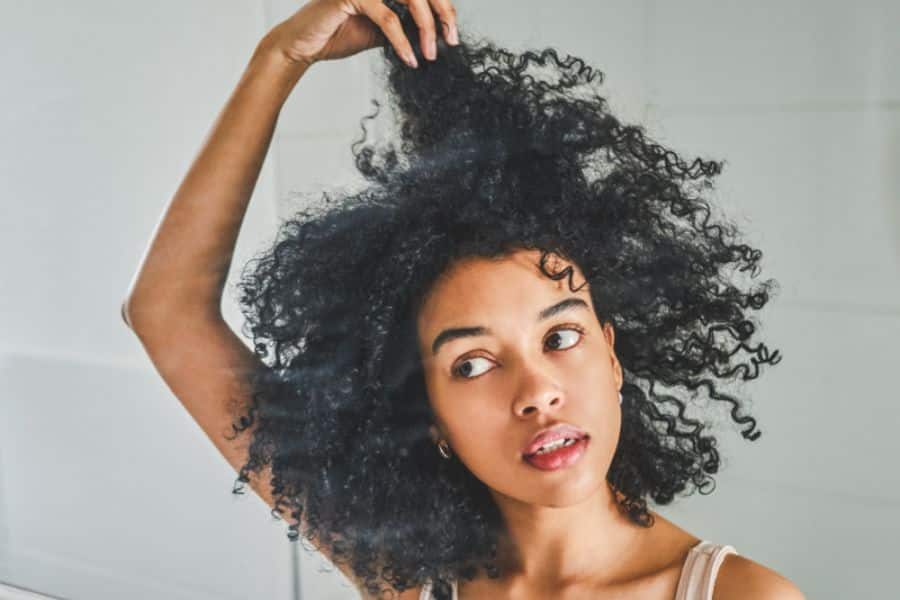Understanding Female Hair Loss
Losing your hair can be a tough pill to swallow, but knowing what’s behind it can help you take charge and get ahead of the issue. Let’s dig into female pattern hair loss and what causes your hair to thin so you can better tackle the situation.
Female Pattern Hair Loss Overview
You’ve probably heard of female pattern hair loss (FPHL), or androgenetic alopecia if you want to get fancy. It’s the top reason for hair thinning among women, and it usually pops up after you’re 30 (Harvard Health Publishing). This affects more than 30 million folks in the US (Cleveland Clinic).
At first, you might notice thinning around your hair part, later getting more prominent on the top of your head. Unlike the guys, most ladies don’t deal with a receding hairline or going complete bald (Mayo Clinic). This slow hair loss can really throw a wrench in your self-confidence, making many women hunt for successful hair loss treatment for women.
Causes of Thinning Hair
Figuring out why your hair’s thinning is key to sorting out the best way to tackle it. Sure, FPHL’s the usual suspect, but there are other players at work:
- Hormonal Changes: Pregnancy, menopause, or thyroid hiccups can mess with your hormone balance, leading to thinning hair.
- Genetics: If hair loss runs in the family, your odds go up.
- Stress: Big emotional or physical stress can send your hair into panic mode.
- Nutritional Deficiencies: Skimping on nutrients like iron, vitamin D, and protein can make your hair strands weak.
- Medical Conditions: Issues like alopecia areata, seborrheic dermatitis, and scalp infections can cause hair patches to fall out.
- Medications: Some drugs, like those used for chemo, antidepressants, and blood pressure management, can thin your hair out.
| Cause | What it does to Your Hair |
|---|---|
| Hormonal Changes | Can trigger shedding and thinning |
| Genetics | Ups the risk of FPHL |
| Stress | May cause shedding |
| Nutritional Deficiencies | Weakens hair strands |
| Medical Conditions | Causes patchy hair loss |
| Medications | Leads to shedding |
When you know what’s behind your thinning hair, you can shape your battle plan better. Munch on foods that promote hair growth and think about medical hair loss treatments to see what works for you.
Try a mix of non-medical and medical routes, like scalp massages and hair growth supplements, to find the best fit for battling hair thinning. Don’t sweat it if there’s no hair loss cure—you can still manage and slow it with the right moves.
Non-Medical Hair Loss Treatments
If your locks are starting to live life on the thin side, diving into non-medical treatments could be your jam. These methods keep you away from the medicine shelf and promise a boost in hair health that could leave you gushing. Two trusty sidekicks in this adventure are scalp massages and microneedling.
Scalp Massages for Hair Thickness
Giving your scalp a little TLC could be just what it needs. A scalp massage isn’t just a spa day for your head; it’s like a workout for your roots. When you get those fingers moving, the blood starts flowing like a river to your hair follicles—inviting thicker growth. Back in 2016, a study revealed that after 24 weeks of scalp love, folks noticed thicker hair (Medical News Today). It’s like a secret handshake for your roots, giving them the goodies they need to thrive.
To jump aboard the massage train, try to spend about 5 minutes twice a day on it. Use those fingertips to make little circles, not too hard, not too soft. Fancy things up a bit by adding essential oils like rosemary or lavender. These oils can turn a simple massage into a growth party for your hair. Want more down-home remedies? Peek at our natural remedies for hair loss.
Microneedling for Hair Regrowth
Now, if you’re ready to get a bit edgy, microneedling might just be your ticket. It’s a fancy word for using a gadget with tiny needles to give your scalp a gentle poke. These micro-pokes encourage the good stuff (growth factors) to step up and energize your hair follicles.
Back in 2013, a study showed that teaming microneedling with some topical minoxidil was like a match made in hair heaven, upping that regrowth game, thickening it all up (Medical News Today).
| Treatment Method | Average Increase in Hair Thickness |
|---|---|
| Scalp Massage (24 weeks) | 30% |
| Microneedling with Minoxidil (12 weeks) | 50% |
Numbers according to Medical News Today
For top-notch results, it’s best to let a pro handle the microneedling. But hey, if DIY is your style, there are at-home kits for the adventurous. Just keep those tools squeaky clean to skip any unwanted nasties sneaking in.
Sprinkle in some hair growth-stimulating supplements and switch up your shampoo to one that tackles hair thinning. Your hair will get the boost right from the get-go.
Non-medical tricks like scalp massages and microneedling could be your secret sauce, giving your confidence—and your hair—a shiny upgrade. Take a stroll through our hair loss treatment reviews for even more goodies that work.
Medical Hair Loss Treatments
If you’re battling thinning hair, you’re not on a solo quest. Lucky for you, there are several go-to remedies to slow down hair loss and maybe even coax out some new strands. We’re diving into some top-notch meds for slowing hair loss and supplements that might give your hair a little extra pep.
Medication for Slowing Hair Thinning
Let’s talk about the good stuff: meds. Perhaps the front-runner here is Minoxidil, aka Rogaine. This baby’s got the thumbs-up from the FDA for helping out with female-pattern hair loss. What it does is give your hair follicles a nudge and encourage regrowth. Stick with it for a solid two months to start seeing changes—patience is your friend here, because things usually start looking pretty good around month four (Harvard Health Publishing). But watch out for skin woes like dryness or unwanted fuzz showing up in funny places.
| Medication | Usage | Time to See Results | Side Effects |
|---|---|---|---|
| Minoxidil (Rogaine) | Daily topical goop | 2 – 4 months | Itchy, dry, or red skin |
Then there’s Finasteride, usually a guy’s ticket, but sometimes a sneaky pick for the ladies. It stops testosterone from turning into its sneaky buddy, DHT, which messes with your hair. Not exactly first draft pick for women, especially before menopause—blame it on potential no-good side effects (Mayo Clinic).
Lastly, meet anti-androgens like spironolactone, which shut down some of those pesky male hormones responsible for hair thinning. If you’ve got PCOS or other conditions with too many androgens, this might be your jam (Harvard Health Publishing). Side effects? Things like feeling woozy or extra thirsty could pop up.
| Medication | Usage | Who It’s For | Possible Hassles |
|---|---|---|---|
| Finasteride (Propecia) | Daily oral pill | Mostly males; cautious pick for females | Nausea, dizzy spells |
| Spironolactone | Daily oral pill | Women with excess male hormones | Dizzy, thirst, bigger jeans |
Sussing out different hair loss treatments for women is your best bet to find what fits your health story.
Hair Growth Stimulating Supplements
Besides prescriptions, you might want to chow down on some supplements to supercharge your hair health. You’re looking at vitamins and minerals that back up strong, growing hair. Most folks chat about Biotin, Iron, Zinc, and Vitamin D as your all-stars for better hair days.
| Supplement | Perks |
|---|---|
| Biotin | Hair and nail toughener |
| Iron | Fights hair shedding linked to low iron |
| Zinc | Keeps oil glands near hair follicles in check |
| Vitamin D | Helps kickstart new hair spots |
Supplements can do wonders, but you might wanna check in with your doc, especially if meds are already in the mix. Knowing how these play with other hair loss treatments is key for getting the most out of your hair plan.
For more deep dives and straight scoop, hop over to our hair loss treatment reviews to see what’s really making waves in the hair world.
Dietary Factors for Hair Health
Getting your hair to look its best starts with feeding it the right stuff. What you put in your body can seriously affect your hair’s condition. Let’s break it down and see how some foods can help keep those locks lush and full.
Foods Promoting Hair Growth
Eating smart is key to having a head full of healthy hair. Here’s the lowdown on what to pile onto your plate:
- Eggs: These little protein bombs are packed with biotin, which is like rocket fuel for hair growth. Plus, they’ve got zinc and selenium that your hair loves.
- Berries: Load up on these for a hit of vitamin C, an antioxidant that shields your hair follicles and helps soak up iron—both vital for keeping hair loss at bay.
- Spinach: This leafy green is full of vitamin A, vitamin C, iron, and folate. It’s the whole package for hair health, getting oxygen to your strands and helping them grow.
- Fatty Fish: Think salmon or mackerel, bursting with omega-3s and proteins that give your hair strength and shine.
- Sweet Potatoes: Packed with beta-carotene which turns into vitamin A—a must for that natural hair oil that keeps your strands smooth.
Importance of Nutrients for Hair
Certain nutrients play a big role in keeping your hair thick and vibrant. Miss out on these, and you might notice your hair getting thinner by the day!
| Nutrient | Good for Hair | Food Sources |
|---|---|---|
| Protein | Builds hair’s structure | Eggs, fatty fish, legumes |
| Biotin | Helps hair grow longer | Eggs, nuts, seeds |
| Vitamin C | Boosts collagen, helps absorb iron | Berries, citrus, leafy greens |
| Iron | Oxygenates hair follicles | Spinach, red meat, lentils |
| Omega-3 Fatty Acids | Feeds hair, reduces scalp itchiness | Fatty fish, flaxseeds, walnuts |
| Vitamin A | Produces sebum, a natural conditioner | Sweet potatoes, carrots, spinach |
| Zinc | Repairs damaged hair | Pumpkin seeds, nuts, shellfish |
Mix these nutrients into your diet and watch your hair bounce back to life. For more about natural solutions, check out our write-ups on natural remedies for hair loss, hair loss treatment for women, and hair regrowth treatments.
Kickstart your journey to happier hair by making smart food choices and exploring baldness treatment products. Now’s the time to take action for the hair you want!
Professional Hair Loss Treatments
Taking a swing at professional hair loss treatments can really change the game for folks troubled by thinning hair. Options like meds and light therapy offer targeted ways to tackle and curb hair loss.
Medication Options for Women
Medications are a go-to for many women trying to handle hair loss. Experts at University of Michigan Health System suggest meds to slow down hair thinning while bulking up hair density. Just keep in mind, these might pinch your wallet as they’re not always covered by insurance and patience is key—it could take a year for you to notice any big changes.
- Minoxidil (Rogaine®): This one’s your go-to for female pattern hair loss (FPHL). You can grab it over the counter in 2% and 5% versions, as per Cleveland Clinic’s advice. Dab it on once a day, and keep at it for at least a couple of months. Peak results usually pop up around the fourth month, according to Harvard Health Publishing. Comes in forms like liquid, foam, and shampoo.
| Medication | How Often | When to Expect Results | Available Forms |
|---|---|---|---|
| Minoxidil (Rogaine) | Daily | 2-4 months | Liquid, Foam, Shampoo |
Curious for more? Check out our hair loss treatments for women section.
Light Therapy for Hair Loss
Light therapy, a.k.a low-level laser therapy (LLLT), is another shot at tackling hair loss like a pro. With this non-invasive treatment, laser gadgets give a boost to hair follicles, spurring on hair growth and taming thinning.
- How It Works: LLLT tools beam red light at a targeted wavelength to nudge hair follicles into action, leading to that extra hair oomph.
- How Often: Generally, you’ll need to sit through LLLT sessions several times a week for a few minutes. Sticking to a schedule is your best bet for solid results.
Though these light gadgets can be home-friendly, chatting with a healthcare pro is wise to see if it’s right for you. Want the full scoop on light therapy for thinning hair? Visit our new hair loss treatments page.
Digging into these professional treatments lets you strut with confidence and take a real shot at dealing with thinning hair.
Coping with Hair Loss
Dealing with hair loss can be a bit of a bummer. But don’t worry, there’s a handful of things you can do to keep your hair looking fab and your spirits high. Here’s a mix of style tips and everyday tweaks to help you out.
Styling Tips for Thinning Hair
When it comes to tackling thin hair, a little bit of styling magic goes a long way. Here’s how to make the most out of what you’ve got:
-
Pump Up the Volume: Go for shampoos and conditioners that promise to boost your hair’s volume. Poof! Your hair looks instantly thicker. Need help choosing? Peek at our guide to the best shampoo for hair loss.
-
Pick the Right ‘Do: Find haircuts that scream volume. Layers, waves, curls—the gang’s all here to help your hair look fuller with extra oomph.
-
Say No to Tight Styles: Leave tight braids and ponytails to the side. They can pull too hard on your hair and make things worse (Mayo Clinic).
-
Lighten Up: Add some highlights or lowlights into the mix for extra dimension and depth. Just stick with gentle, friendly products to keep your hair happy.
-
Rock a Wig or Extensions: Quick fix? Try wigs or hair extensions. They’re not just for costume parties! Plus, sometimes insurance might even pitch in if it’s medical (Mayo Clinic).
-
Go Fully Bald: If you’re bold, embrace the shiny dome. Bye-bye, bad hair days!
Lifestyle Remedies for Hair Loss
Small changes and DIY tricks can also do wonders for thinning hair. Here’s how:
-
Eat Your Greens: Munch on foods packed with vitamins and minerals like greens, berries, nuts, and lean meats. Your hair will thank you. More info in our article about foods promoting hair growth.
-
Chill Out: Stress is a hair’s worst nightmare. Shake it off with yoga, meditation, or a good jog. Sometimes hair falls due to stress and a little chill time is all it needs to bounce back (Cleveland Clinic).
-
Avoid Fiery Tools: Cut down on hair dryers and straighteners. If you gotta use them, protect those strands with a heat spray.
-
Be Gentle: Treat your hair with the kindness of a puppy. Use gentle products and ditch the towel rubdown for a gentle pat. Check out natural remedies for hair loss.
| Styling Tips | Lifestyle Remedies |
|---|---|
| Volumizing products | Balanced meals |
| Snazzy hairstyles | Chill sessions |
| Loose hair, happy scalp | Ditch the heat |
| Add color | Treat gently |
| Wigs/extensions |
Try these tricks to beef up your confidence and keep thinning hair in check. If you’re hunting for more options, jump into our section on hair loss treatment for women. And don’t forget, a quick chat with your doc can open doors to more hair regrowth treatments.










